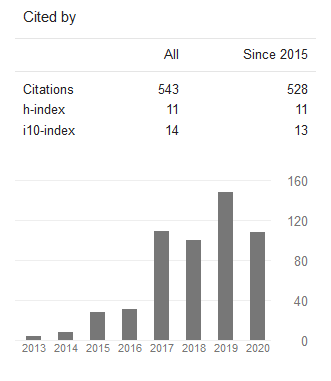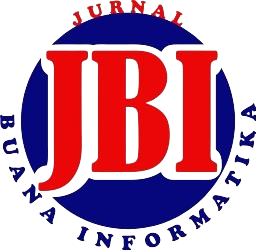Implementasi Ekstraksi Ciri Histogram dan K-Nearest Neighbor untuk Klasifikasi Jenis Tanah di Kota Banjar, Jawa Barat
DOI:
https://doi.org/10.24002/jbi.v10i2.2141Abstract
Abstract.
Land plays an essential role in the availability of nutrients and water to support our life on earth. Soil quality can be observed based on its color and texture characteristics. By knowing the quality of the soil, the most suitable plants for planting can be determined. This study is conducted to examine the soil quality in Langensari. The most regions in Langensari are in the altitude of fewer than 25 meters above sea level that they are very potential for agriculture and plantation. The proposed system used in this research is a cross-sectional image of the ground as input. The image is then extracted using histogram feature extraction to obtain the intensity, standard deviation, skewness, energy, entropy and smoothness values. K-Nearest Neighbor is then used to classify the results. The proposed system was tested using 20 test images. Based on the experiment result, the system can classify soil types appropriately with accuracy reaching 60% when value of K = 1and K=3.
Keywords: Soil Types Classification, Histogram Feature Extraction, K-Nearest Neighbor, Website.
Abstrak.
Tanah memegang peranan penting dalam tersedianya unsur hara dan air bagi kehidupan makhluk hidup di bumi. Kualitas tanah dapat diketahui dari karakteristik warna dan teksturnya. Dengan mengetahui kualitas tanah, jenis tanaman yang paling tepat untuk ditanam dapat ditentukan. Penelitian ini mengenai kualitas tanah di Langensari. Sebagian besar wilayah Langensari dipilih karena memiliki ketinggian kurang dari 25 mdpl dimana sangat berpotensi sebagai daerah pertanian dan perkebunan. Sistem yang diusulkan menggunakan citra penampang tanah sebagai inputan. Citra kemudian diekstrak menggunakan ekstraksi ciri histogram untuk mendapatkan nilai intensitas, standar deviasi, skewness, energi, entropi, dan smoothness. Fitur yang dihasilkan kemudian diklasifikasikan menggunakan algoritma K-Nearest Neighbor. Sistem yang diusulkan diuji menggunakan 20 citra uji. Berdasarkan hasil pengujian, sistem mampu mengklasifikasikan jenis tanah secara tepat dengan akurasi mencapai 60% saat nilai K = 1 dan nilai K=3.
Kata Kunci: Klasifikasi Jenis Tanah, Ekstraksi Ciri Histogram, K-Nearest Neighbor, Website.
References
E. A. Gandirum, Kota Banjar dalam Angka Tahun 2015. Banjar, 2015.
N. T. Basuki, Kota Banjar Dalam Angka 2018. Banjar: BPS Kota Banjar, 2018.
A. H. Munsell, Munsell Soil Book of Color. Michigan USA: X-Rite Incorporated, 2009.
Y. Udovychenko, A. Popov, and I. Chaikovsky, “Ischemic heart disease recognition by k-NN classification of current density distribution maps,” in International Conference on Electronics and Nanotechnology (ELNANO), 2015.
Y. Han, K. Virupakshappa, and E. Oruklu, “Robust traffic sign recognition with feature extraction and k-NN classification methods,” in International Conference on Electro/Information Technology (EIT), 2015.
W. D. N. Pacheco and F. R. J. López, “Tomato classification according to organoleptic maturity (coloration) using machine learning algorithms K-NN, MLP, and K-Means Clustering,” in XXII Symposium on Image, Signal Processing and Artificial Vision (STSIVA), 2019.
C. Eyupoglu, “Implementation of color face recognition using PCA and k-NN classifier,” in IEEE NW Russia Young Researchers in Electrical and Electronic Engineering Conference (EIConRusNW), 2016.
E. C. Ozan, E. Riabchenko, S. Kiranyaz, and M. Gabbouj, “A vector quantization based k-NN approach for large-scale image classification,” in A vector quantization based k-NN approach for large-scale image classification, 2016.
P. Dewangan and V. Dedhe, “Soil Classification Using Image Processing and Modified SVM Classifier,” Int. J. Trend Sci. Res. Dev., vol. II, no. 6, pp. 504–507, 2018.
U. Barman and R. D. Choudhury, “Soil texture classification using multi class support vector machine,” Inf. Process. Agric., 2019.
S. K. Honawad, S. S. Chinchali, K. Pawar, and P. Deshpande, “Soil Classification and Suitable Crop Prediction,” in National Conference On Advances In Computational Biology, Communication, And Data Analytics, 2017, pp. 25–29.
D. A. Bimantoro, “Klasifikasi Tanah Humus Berdasarkan Citra RGB Menggunakan Metode K-Nearest Neighbor (KNN),” J. Sains dan Teknol., vol. IV, no. 7, pp. 12–27, 2016.
I. H. Robbani, E. Trisnawati, R. Noviyanti, A. Rivaldi, and F. Utaminingrum, “Aplikasi Mobile Scotect: Aplikasi Deteksi Warna Tanah Dengan Teknologi Citra Digital Pada Android,” J. Teknol. Inf. dan Ilmu Komput., vol. III, no. 1, pp. 19–26, 2016.
Y. I. N and A. Tristiyono, “Aplikasi Pengenalan Jenis Tanah Untuk Lahan Pertanian Dengan Menggunakan Metode Euclidean Distance,” MIND J., vol. I, no. 1, pp. 26–35, 2016.
V. M. Dolas and P. U. Joshi, “A Novel Approach for Classification of Soil and Crop Prediction,” Int. J. Comput. Sci. Mob. Comput., vol. 7, no. 3, pp. 20–24, 2018.
S. Hardjowigeno, Ilmu Tanah, Edisi Ketiga. Jakarta, Indonesia: PT. Mediyatama Sarana Perkasa, 2013.
K. Padmavathi and K. Thangadurai, “Implementation of RGB and Grayscale Images in Plant Leaves Disease Detection – Comparative Study,” Indian J. Sci. Technol., vol. 9, no. February, pp. 4–9, 2016.
F. Muwardi and A. Fadlil, “PENGOLAHAN CITRA DAN PENGKLASIFIKASI JARAK,” J. Ilmu Tek. Elektro Komput. dan Inform., vol. 3, no. 2, pp. 124–131, 2017.
M. Kaur and R. K. Randhawa, “Texture Based Classification of Indian Soils Using Local Binary Pattern and Artificial Neural Networks,” Int. J. Electron. Comput. Sci. Eng., vol. 4, no. 3, pp. 228–237, 1956.
M. R. Alghifari and A. P. Wibowo, “Penerapan Metode K-Nearest Neighbor Untuk Klasifikasi Kinerja Satpam Berbasis Web,” J. Teknol. Manaj. Inform., vol. V, no. 1, 2019.
S. A. Siddiqui and N. Fatima, “Indian Soils : Identification and Classification,” Earth Sci. India, vol. 10, no. III, pp. 1–14, 2017.
S. Perumal and T. Velmurugan, “Preprocessing by Contrast Enhancement Techniques for Medical Images,” Int. J. Pure Appl. Math., vol. 118, no. 18, pp. 3681–3688, 2018.
H. R. Thaker and C. K. Kumbharana, “Study and Analysis of various preprocessing approaches to enhance Offline Handwritten Gujarati Numerals for feature extraction,” Int. J. Sci. Res. Publ., vol. 4, no. 7, pp. 1–5, 2014.
H. Obara, Y. Maejima, K. Kohyama, T. Ohkura, and Y. Takata, “Outline of the Comprehensive Soil Classification System of Japan – First Approximation,” Japan Agric. Res. Q., vol. 49, no. 3, pp. 217–226, 2015.
Chandan and R. Thakur, “Recent Trends Of Machine Learning In Soil Classification : A Review,” Int. J. Comput. Eng. Res., vol. VIII, no. 9, pp. 25–32, 2018.
Downloads
Published
Issue
Section
License
Copyright of this journal is assigned to Jurnal Buana Informatika as the journal publisher by the knowledge of author, whilst the moral right of the publication belongs to author. Every printed and electronic publications are open access for educational purposes, research, and library. The editorial board is not responsible for copyright violation to the other than them aims mentioned before. The reproduction of any part of this journal (printed or online) will be allowed only with a written permission from Jurnal Buana Informatika.
This work is licensed under a Creative Commons Attribution-ShareAlike 4.0 International License.










